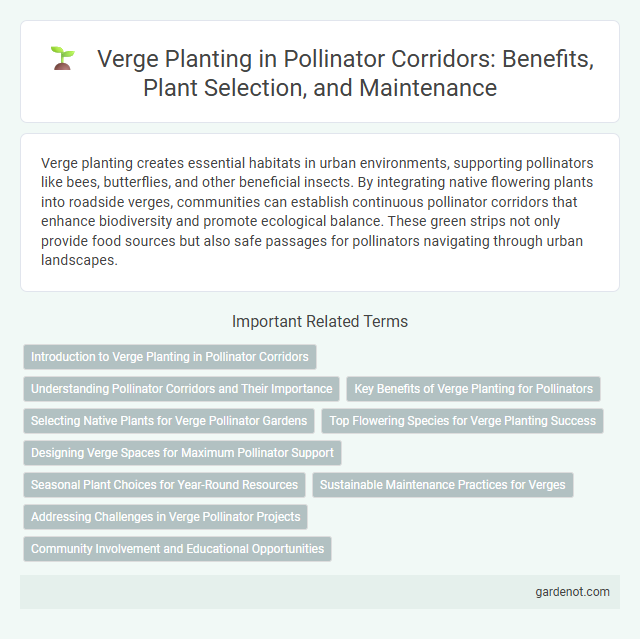Verge planting creates essential habitats in urban environments, supporting pollinators like bees, butterflies, and other beneficial insects. By integrating native flowering plants into roadside verges, communities can establish continuous pollinator corridors that enhance biodiversity and promote ecological balance. These green strips not only provide food sources but also safe passages for pollinators navigating through urban landscapes.
Introduction to Verge Planting in Pollinator Corridors
Verge planting in pollinator corridors creates essential habitats by introducing native flowering plants along road edges, enhancing biodiversity and supporting pollinator populations such as bees, butterflies, and hoverflies. Incorporating diverse plant species that bloom at different times ensures continuous nectar and pollen supply, promoting ecological resilience and connectivity between fragmented habitats. This strategic vegetation design improves ecosystem services, including pollination and soil stabilization, while contributing to landscape aesthetics and environmental sustainability.
Understanding Pollinator Corridors and Their Importance
Pollinator corridors consist of strategically planted verges designed to provide continuous habitats for bees, butterflies, and other essential pollinators, facilitating their movement and foraging activities. These corridors enhance biodiversity by linking fragmented habitats, supporting pollination services critical for agriculture and natural ecosystems. Effective verge planting includes native flowering plants rich in nectar and pollen, which sustain pollinator populations and promote ecological resilience.
Key Benefits of Verge Planting for Pollinators
Verge planting creates vital habitats that support diverse pollinator species by providing continuous sources of nectar and pollen throughout the flowering season. These green corridors enhance biodiversity, improve ecosystem resilience, and facilitate pollinator movement across urban and rural landscapes. Increased pollinator activity from verge planting directly benefits agricultural productivity and the regeneration of native plant communities.
Selecting Native Plants for Verge Pollinator Gardens
Selecting native plants for verge pollinator gardens enhances local biodiversity by providing essential nectar and pollen sources. Species such as milkweed, coneflowers, and goldenrod attract native bees, butterflies, and other pollinators adapted to the regional climate. Choosing drought-tolerant and low-maintenance native varieties ensures resilient verge vegetation that supports pollinator corridors effectively.
Top Flowering Species for Verge Planting Success
Top flowering species for verge planting include native wildflowers such as Echinacea purpurea, Asclepias tuberosa, and Rudbeckia hirta, which provide essential nectar and pollen sources for pollinators. Selecting drought-tolerant, low-maintenance flowers like Gaillardia and Monarda ensures thriving plant communities that support bees, butterflies, and other pollinators. Incorporating diverse blooming periods maximizes forage availability throughout the growing season, enhancing pollinator corridor effectiveness.
Designing Verge Spaces for Maximum Pollinator Support
Designing verge spaces for maximum pollinator support involves selecting native flowering plants that bloom sequentially to provide continuous nectar sources throughout the seasons. Incorporating diverse plant heights and structures creates microhabitats that attract a variety of pollinators such as bees, butterflies, and hoverflies. Proper soil preparation and minimizing pesticide use contribute to establishing healthy, resilient verge corridors that sustain local pollinator populations and enhance urban biodiversity.
Seasonal Plant Choices for Year-Round Resources
Selecting seasonal plants for verge planting in pollinator corridors ensures continuous nectar and pollen availability from early spring to late autumn. Incorporating native wildflowers, such as purple coneflower (Echinacea purpurea) in summer and goldenrod (Solidago spp.) in fall, supports diverse pollinator species throughout the year. Strategic layering of bloom periods enhances ecosystem resilience and promotes sustained pollinator activity in urban and rural landscapes.
Sustainable Maintenance Practices for Verges
Sustainable maintenance practices for verge planting emphasize selecting native pollinator-friendly plants that require minimal irrigation and chemical inputs, promoting biodiversity and reducing environmental impact. Implementing mowing schedules that protect flowering periods supports pollinator life cycles while controlling invasive species ensures the health of the corridor. Soil health management through organic mulching and minimal disturbance techniques enhances plant resilience and long-term sustainability of verge ecosystems.
Addressing Challenges in Verge Pollinator Projects
Verge planting in pollinator corridors often faces challenges such as limited space, soil compaction, and invasive species that hinder native plant growth. Selecting drought-tolerant, native flowering plants with staggered bloom periods ensures continuous food sources for pollinators and enhances habitat resilience. Regular community engagement and strategic maintenance plans help mitigate these issues and sustain thriving pollinator populations.
Community Involvement and Educational Opportunities
Verge planting enhances pollinator corridors by engaging local communities in creating and maintaining habitats that support bees, butterflies, and other vital pollinators. Community involvement fosters stewardship and raises awareness about biodiversity through workshops, planting days, and citizen science projects. Educational opportunities connected to verge planting provide hands-on learning experiences that inspire conservation efforts and promote sustainable urban ecosystems.
Verge planting Infographic

 gardenot.com
gardenot.com